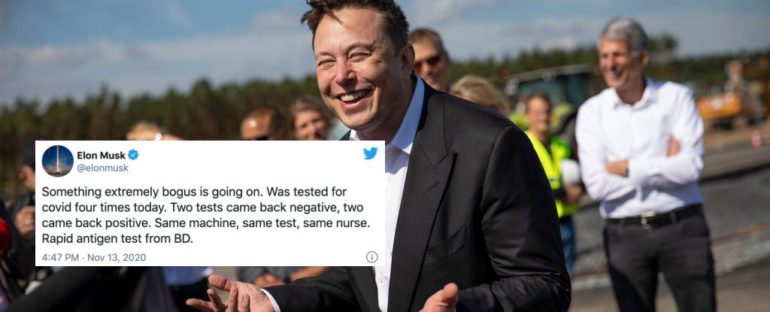On Friday 13th November, Elon Musk took four rapid antigen tests for COVID-19. When the results came back two were negative and two were positive. Musk was alarmed. He took to Twitter complaining “Something extremely bogus is going on.”
What’s bogus is that ‘Space Karen‘ didn’t read up on the test before tweeting to his millions of followers. Here’s why his results make perfect sense.
Something extremely bogus is going on. Was tested for covid four times today. Two tests came back negative, two came back positive. Same machine, same test, same nurse. Rapid antigen test from BD.
— Elon Musk (@elonmusk) November 13, 2020
In August, when the FDA approved the first COVID-19 rapid antigen test, they made the comparison to at-home pregnancy tests. They’re cheap, don’t need a lab, and give results in minutes.
They’re also only accurate during a certain window of time. Rapid antigen tests work by detecting a protein found on the surface of the virus. The greater the number of virus particles in your body, the more likely you are to detect it.
The number of virus particles peaks as symptoms appear. In the days, even hours, either side of peak viral load, the likelihood of a false negative increases.
COVID-19 is most contagious two days before symptoms emerge. Thus, a rapid antigen test may well return a false negative when an infected person most needs to isolate.
The White House’s over-reliance on rapid antigen testing may have contributed to their super-spreader events. Elon Musk’s two false negatives are in line with the known limitations of rapid antigen testing.
After raising suspicions about rapid antigen testing, Musk moved on to PCR testing. “Is it possible to generate a false positive if you simply run enough cycles?” he asked.
What is the general population (no knowledge of symptoms) accuracy of a sars-cov2 PCR test & is it possible to generate a false positive if you simply run enough cycles?
— Elon Musk (@elonmusk) November 13, 2020
The answer is no.
PCR, or polymerase chain reaction, is a lab technique for replicating a specific piece of DNA.
We combine our biological sample with all the ingredients required to replicate DNA. Then we add DNA primers targeting our sequence of interest.
Compared to rapid antigen testing, PCR testing has some downsides. It’s expensive, requires a lab to perform, and the experiment itself takes hours. However, it’s accurate over a much longer period of time.
PCR relies on the DNA of interest being present in the sample in the first place. False positives result from contamination. That’s why we include a negative control.
Instead of adding your nose swab DNA sample to the negative control, you add pure, distilled water. If you see a positive result in the negative control, you know you contaminated your sample.
But what about the ‘cycles’ Musk refers to? At room temperature, the DNA replication would take a very, very long time. We heat the reaction to speed it up, then lower the temperature to 4°C to stop it. That’s one thermal cycle.
Depending on the design of the experiment we might perform 30 – 40 thermal cycles. But, the total number of PCR cycles doesn’t determine the result. We measure the amount of target DNA at a predetermined number of cycles.
That cycle threshold is consistent for all PCR experiments conducted by the lab that target this piece of DNA. @c0nc0rdance provides the best explanation of this I’ve seen:
“Number of cycles” doesn’t matter. Where you set the threshold does. Saying “we’re running too many cycles” is like saying “we’re recording too much security video after the crime was committed”. It doesn’t matter.
I develop & support PCR diagnostics for a living.
“Number of cycles” doesn’t matter. *Where you set the threshold* does.
Saying “we’re running too many cycles” is like saying “we’re recording too much security video after the crime was committed”. It doesn’t matter.
— c0nc0rdance (@c0nc0rdance) November 13, 2020
There’s a third type of COVID-19 test: antibody testing.
Instead of detecting the virus itself, antibody testing looks for evidence of an immune response to the virus. When your immune system meets a new virus or bacteria it mounts an attack to destroy it.
At the same time, part of your immune system creates antibodies that recognise the virus or bacteria. They’re the immunological equivalent of a wanted poster.
Antibody testing looks for antibodies specific to COVID-19. If we can detect those antibodies, the COVID-19 virus must have infected the person in question.
Antibodies remain in your blood for a long time after an infection. This means antibody testing is a reliable detection. However, it takes time for your immune system to generate antibodies to a new threat. Thus, antibody testing is ineffective in the first days of infection.
The three types of COVID-19 test available — PCR, antibody, and rapid antigen — each have their limitations. They ask the question “Is there evidence of COVID-19 in this sample?” in different ways. It’s important we understand those limitations and differences when interpreting results.
Emma Bell is a bioinformatician at the Princess Margaret Cancer Centre, Toronto, Canada. They use computer programming, statistics, and machine learning to better understand cancer biology.
This article was originally published by Emma Bell Ph.D. on Medium. Read the original article here.
References
Rubin, R. JAMA. (2020) The Challenges of Expanding Rapid Tests to Curb COVID-19
Guglielmi, G. Nature (2020) Fast coronavirus tests: what they can and can’t do.
Centers for Disease Control and Prevention (2020) Test for past infection



